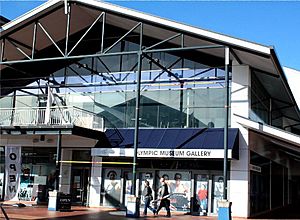New Zealand Olympic Museum facts for kids

Exterior of former New Zealand Olympic Museum building
|
|
| Established | 1998-2013 |
|---|---|
| Location | Wellington, New Zealand (closed) |
The New Zealand Olympic Museum was a special place that celebrated New Zealand's journey in the Olympic Games. It was located in Wellington, New Zealand, on Queens Wharf. The museum opened its doors on June 23, 1998.
It closed in January 2013 when the New Zealand Olympic Committee (NZOC) moved its main office to Auckland. The museum's main goal was to show New Zealand's part in the Olympic movement. It also aimed to share the important values of the Olympics, like friendship and respect.
Contents
New Zealand Olympic Museum
This museum was a treasure chest of New Zealand's Olympic history. It helped people learn about the athletes and their amazing achievements. The museum also taught visitors about the spirit of the Olympic Games.
What Was Inside?
The museum displayed many interesting items from New Zealand's Olympic past. One important item was the Lonsdale Cup (NZOC). This cup is a special award given to New Zealand's top athletes. It was always on show for visitors to see.
Another very special item was the Te Mahutonga Cloak. This beautiful cloak is a significant Māori treasure. It traveled with the New Zealand Olympic team to the games. When it was not at the Olympics, it was proudly displayed at the museum.
The Te Mahutonga Cloak and Stone
On June 23, 2004, which is known as Olympic Day, a special event happened. The Te Runanga O Ngai Tahu, a major Māori tribe, gave two greenstone gifts to the New Zealand Olympic Committee. These gifts are called taonga, which means treasured possessions.
One gift was a pendant. This pendant was designed to travel with the Te Mahutonga Cloak. The other gift was a Māori touchstone. This special stone traveled with the New Zealand Olympic Team to all the games after 2004. It was a symbol of good luck and connection to home.
More About New Zealand at the Olympics
- New Zealand at the Olympics
- New Zealand Olympic medallists
Find Out More
- New Zealand Olympic Museum
- Featured New Zealand Olympic Museum Collection
See also
 In Spanish: Museo Olímpico de Nueva Zelanda para niños
In Spanish: Museo Olímpico de Nueva Zelanda para niños

